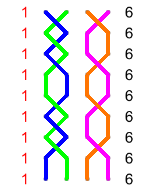Advanced Kaleidoscope Ringing
Last time we looked at teaching the basics kaleidoscope works. But there may be times when more advanced sequences may be useful to your band. When might more advanced kaleidoscope ringing be useful for developing skills in my ringers?

Treble bob in 2/3 and places in 4/5

Yorkshire places

Stedman back-work
Using Kaleidoscope ringing
- There may be times when the band meets short, or at least is short at the beginning of practice before everyone arrives!
Advanced kaleidoscope sequences may be used to practise the skills for ringing certain sections of methods that will be rung later. - There may be a time when you wish to emphasise the need for accurate striking to your ringers.
These sequences provide a form of ringing where the ringer finds it easier to hear their bell as the bells frequently return to the familiar sound of rounds. - You may run a band where there is insufficient experience for your ringers to move on to method ringing.
Kaleidoscope ringing provides more variety for your ringers and can be used to ring for services and other ringing performances.
It is possible for a ringer to learn for example: Treble bob hunt, Yorkshire Places, Stedman back work within two places. Cambridge front work could also be learned in this way with one bell ringing the line and the other bell having the more difficult task of fitting in around it.
These exercises familiarise ringers which pieces of ringing which they will meet later on when they move on to ringing methods.
Kaleidoscope ringing on higher numbers
Towers with higher numbers of bells sometimes find themselves in a position where they do not have sufficient advanced ringers to ring methods on the all the bells. Kaleidoscope ringing can provide a useful addition to ringing call changes providing more variety and consequently helping to maintain interest. It can be used with different skills levels, the more advanced ringers ringing sequences which are part of methods or which include dodging. Less able ringers could be put to ring Long Places with four blows in each place.
Why not customise your own Kaleidoscope sequence?
So start with the sequence might have a “separator”. So for example a sequence can be rung in 1 /2 with the 3 staying in thirds place and the 4 and 5 ringing a different sequence.This has the advantage of stabilising the ringing by keeping the 3 and the 6 in their home places and gives both the ringers of those bells an opportunity to learn to cover. As the ringers skills progress, the sequences can made more complex. For example, the teacher might start with the bells in 2/3 making long places, 4 staying in 4ths place and the bells in 5/6 making short places and move on to bells 1/2 treble bob hunting or ringing Cambridge front work with the bells in 3/4 making places and the bells in 5/6 staying still.
If your band has insufficient capable ringers to ring methods or you wish to build skills in certain ringers you can make up your own sequence to suit your band. Give it a name and ring it for service. Why not name it after your tower or one of your ringers! St Peters Places or Sheila’s Shuffle for example!
The possibilities are endless! Set your imagination free!

Direct your ringers to this SmART Ringer page where they can learn more about Kaleidoscope ringing.
Pip Penney